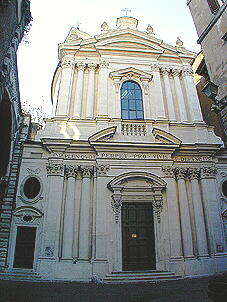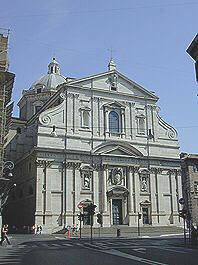Around Campo de' Fiori:
Via Giulia, Largo Argentina,
Via del Corso
Back to the "Piazza Campo de' Fiori general presentation" |
Properties in this area:
"THE TURTLES' DREAM": wonderful four bedroom three bathrooms, amazing sitting room, separate large dining room / kitchen, terrace in historical palace facing the Turtle Fountain. Elevator. New! Highly recommended (up to 8 guests).
"The TURTLES NEST": Finest four bedroom three bathroom apartment with sitting room, dining room, panoramic terrace / roof garden with stunning Rome views, BBQ and additional kitchen, in an elegant historical palace facing the famous Tortoise fountain. Excellent fittings and equipment. Elevator! (up to 8 guests).
New! Highly recommended. |
Around Campo de' Fiori you find many noteworthy sights and areas worth visiting.
VIA GIULIA
At the beginning of the 16th century Pope Julius II replaced the maze of streets from the Capitol to the Vatican with a long straight street to which he gave his name.
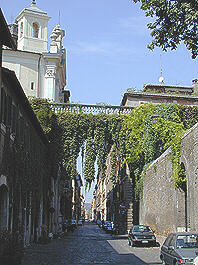 |
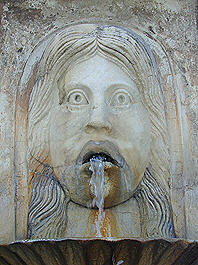 |
Via Giulia
|
Via Giulia, the Fontana del Mascherone
(big mask fountain) |
For centuries Via Giulia has been Rome's most important street, dotted with palazzi and churches, adjacent to a picturesque neighborhood bustling with travellers and tradesmen.
There are many churches along Via Giulia. To the right flank
of the Palazzo Farnese there is the lovely church "Santa
Maria del Suffragio", dedicated to the mourning
of the dead. The Neapolitans had their national church "Spirito
Santo dei Napoletani.
The Florentines had the Basilica of St. Giovanni dei Fiorentini,
dedicated to St. John Baptist, the patron saint of Florence,
commissioned by the Medici Leo X, built with contributions
of Sansovino, Sangallo the Younger, Della Porta, Maderno,
A. Galilei, Bromine.
|
|
Santa Maria del
Suffragio |
|
POMPEY'S THEATRE and the AREA SACRA of LARGO ARGENTINA
Walking towards the Capitol Hill (Piazza Venezia, towards East), one reaches the Area Sacra dell'Argentina, and the remains of Pompey's Theater and Curia. Pompey built the theatre on his own land, and topped it with a temple dedicated to Venus Victrix (the Goddess of Victory). The theater, which could seat 18,000 spectators, was inaugurated in 65 BC, with literary and musical events, and with hunts lasting several days, in which lions, elephants, and lynxes were massacred.
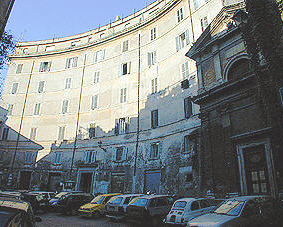 |
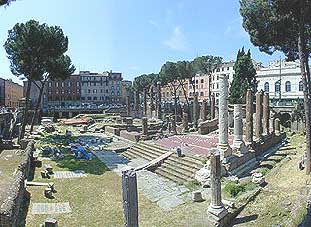 |
Via Grotta di Pinta: palazzi following the curve of the Theater of Pompey |
The Republican Temples of Largo Argentina (site of Julius Caesar's assassination) |
The inner curve of the theatre is faithfully echoed by the shape of the buildings of Via Grotta di Pinta, one of the most remarkable examples of urban continuity in Rome. Parts of the theatre's walls still exist in the basements of the buildings of the area.
Behind the stage a portico of massive dimensions was erected, having at its end an exedra, which became the Curia (meeting place) of the Senate. This is were Julius Caesar was assassinated. The Curia is part of the Area Sacra of Largo Argentina. In this area your find the excavations of four temples of the Roman Republic, together with the ruins of Pompey's Curia (left photo). In the same photo, to the right, you can see the Teatro Argentina, where Rossini presented the premiere of the Barber of Seville in 1816. All the great Italian composers subsequently had their works released here.
SANT'ANDREA della VALLE and the CHIESA DEL GESU'
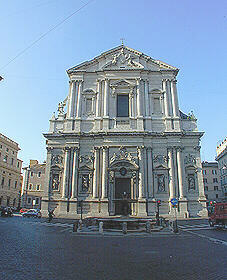 |
Walking towards Piazza Venezia and Capitol Hill (Campidoglio) one finds two important churches: Sant'Andrea della Valle and the Chiesa del Gesu' (Jesus Church).
Sant'Andrea della Valle, near Piazza Navona, is the main church of the Theatine Order, founded in 1524 by St. Gaetano di Thiene.
Sant'Andrea della Valle, facade |
The church t has the highest dome in Rome after St. Peter's, and it was built following the plans of many architects (G. della Porta, Carlo Maderno, Rainaldi and Fontana).
The relative nudity of the nave contrasts with the rich frescoes, of which the most notables are those of the Evangelists in the four pendentives, by Domenichino.
The domes of Sant'Andrea della Valle and of St. Peter seen from the Victor Emmanuel monument |
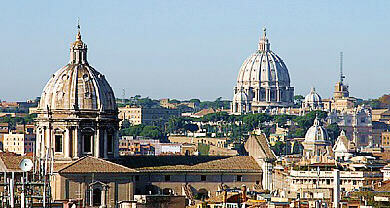 |
|
Just before you reach Capitol Hill you find the splendid Jesus Church (Chiesa del Gesu'), which was built between 1568 and 1578.
It is the church of the Jesuit order, which became the model of Counter-Reformation churches in Europe. The facade is by Giacomo della Porta. The interior is by Vignola, and is exceptionally rich, with sumptuous details in coloured marble and lapis lazuli.
Perhaps the major masterpiece is the fresco in the vault of the nave, the "Triumph of the name of Jesus". The author is Giovanni Battista Gaulli, also called Baciccia, contemporary of Bernini (17th century), and having his exuberant style. Also the Chapel of St. Ignatius of Loyola by Andrea Pozzo (1696-1700) is renowned for its opulence. |
Back to the "Piazza Campo de' Fiori general presentation"

Visit Rome | Rome panoramic views | Rome apartments and villas | Inquire | Rome travel guide | Rome map | Service | Resources
Roman Homes homepage |




